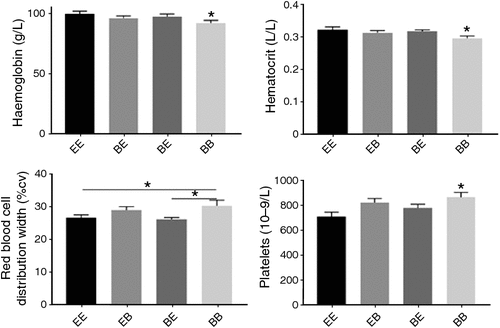Provision of enrichment blocks alters red blood cell parameters in sucker and weaner pigs
S. A. Barnes A , S. Kitessa A , G. M. Cronin B and C. R. Ralph A CA Animal Welfare Science Centre, South Australian Research and Development Institute, Roseworthy, SA 5371.
B The University of Sydney, Camden, NSW 2570.
C Corresponding author. Email: cameron.ralph@sa.gov.au
Animal Production Science 57(12) 2449-2449 https://doi.org/10.1071/ANv57n12Ab048
Published: 20 November 2017
Providing animals with enrichment can decrease antagonistic behaviours (Beattie et al. 1995; van Nieuwamerongen et al. 2015), enhance learning ability (Bolhuis et al. 2013), and decrease oxidative stress in hippocampal slice cultures though modification of immune cell secretions (Pusic et al. 2016). We investigated the effect of providing sucker and weaner pigs with enrichment in the form of a specially formulated enrichment block for sucker and weaner pigs (Ridleys Corporation, Toowong, Qld, Australia). We hypothesised that the provision of enrichment blocks would attenuate the inflammatory response. Piglets (Large White × Landrace cross) were housed in conventional farrowing crates for 21 days during lactation and in group pens for 9 weeks post weaning. Prior to weaning pigs were housed in either a pen with enrichment blocks (enriched) or without enrichment blocks (barren). Enrichment blocks were provided from d 7 of life. At weaning, the pigs were weaned into pens with enrichment blocks (enriched) or without enrichment blocks (barren). This resulted in four treatments in a 2 × 2 factorial design: enriched in sucker and weaner phases (EE; n = 10), enriched in the sucker phase and barren in the weaner phase (EB; n = 12), barren in the sucker phase and enriched the weaner phase (BE; n = 11) and barren in sucker and weaner phases (BB; n = 12). Food and water were provided ad libitum during the weaner phase. Blocks were replaced weekly and increased in size to match piglet size. Blood samples (3 mL) were collected via jugular venepuncture at 1 day before weaning, 1 day post weaning, and 21 days post weaning for complete blood count on a haematology analyser (Abbott Cell Dyn 3700, Abbott Laboratories, Chicago, IL, USA). Data were analysed using a repeated-measures ANOVA and a general linear model in SPSS v23.0 (IBM, Armonk, NY, USA). Haemoglobin and haematocrit were less in the BB group than the BE, EB and EE groups (P < 0.05). Red blood cell (RBC) distribution width was greater in the BB group than in EE and BE groups (P < 0.05), but was not different than the EB group (P > 0.05). The number of platelets was greater in the BB group than the BE, EB or EE groups (Fig. 1; P < 0.05).

|
The difference in haemoglobin, haematocrit, variation in red blood cell width, and platelet concentration in the enriched groups are consistent with an attenuated inflammatory status. Our data therefore suggest pigs provided with enrichment blocks within the first 11 weeks of life have a lowered inflammatory status and the provision of enrichment blocks can influence inflammatory status and potentially immune function of sucker and weaner pigs. However, the implications of this for the long-term welfare and productivity of sucker and weaner pigs requires further investigation.
References
Beattie VE, Sneddon N, Walker IA (1995) Animal Welfare 4, 207–220.Bolhuis JE, Oostindjer M, Hoeks CWF, de Haas EN, Bartels AC, Ooms M, Kemp B (2013) Animal Cognition 16, 845–850.
| Crossref | GoogleScholarGoogle Scholar |
Pusic KM, Pusic AD, Kraig RP (2016) Cellular and Molecular Neurobiology 36, 313–325.
| Crossref | GoogleScholarGoogle Scholar |
van Nieuwamerongen SE, Soede NM, van der Peet-Schwering CMC, Kemp B, Bolhuis JE (2015) Journal of Animal Science 93, 5442–5454.
| Crossref | GoogleScholarGoogle Scholar |
Supported by Australian Pork Limited. We acknowledge the intellectual and technical input of Dr Ian Beckman and the technical assistance of Jessica Zemitis, Tanya Nowland, Lisa McKenny, and Bryony Tucker. Rob Parkes and Matt Callaghan of Ridleys Corporation Ltd for making the enrichment blocks.


